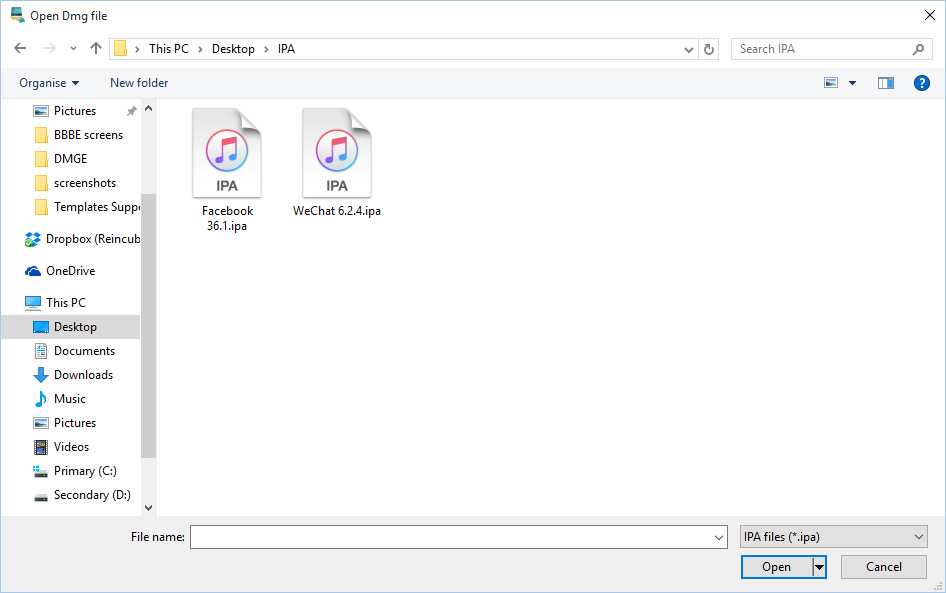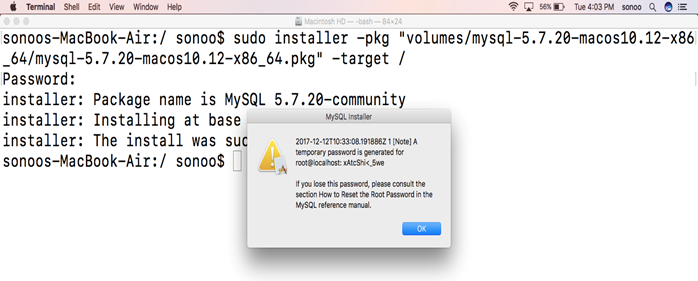MySQL Workbench for Mac is a unified visual tool for database architects, developers, and DBAs.MySQL Workbench provides data modeling, SQL development, and comprehensive administration tools for server configuration, user administration, backup, and much more. Most Mac OS applications downloaded from outside the App Store come inside a DMG file. Like if you wanna download MySQL 5 for mac from this page, you’ll directly get the.dmg installation file into your MAC. First, download the MySQL 5.dmg installation file from the official link on above.
Getting Started with 'Terminal' - MUST READ Before You Start Programming
Programmers use 'Terminal' to issue commands, instead of the graphical user interface - which is meant for common users.
You MUST have some basic knowledge on using the Terminal and the file system. Read 'Unix Survival Guide for Mac & Ubuntu - Terminal, File System and Users'.
Mysql For Mac
How to Install JDK and Get Started with Java Programming on Mac
Read HERE.
Programming Text Editors for Mac
TextEdit for Mac
TextEdit (the default text editor in Mac OS X) is NOT a programming text editor, as it lacks features like syntax highlighting. I strongly suggest you install a programming text editor.
https://ninnfc.netlify.app/water-dmg-un-walls-shows-above-crown-omlding.html. It will also help protect the stone from absorbing the grout.! Hang in there, you’re almost done.What do you think? Do you feel like you can tackle your own tile setting project? It was easy to wipe on and buff off.
To use TextEdit to write source file, you need to open a new file ⇒ choose 'Format' ⇒ 'Make Plain Text'.
You can open an existing file in TextEdit from Terminal by issuing:
nano (or pico) Command-line Text Editor
nano is a GNU text editor that is available for Unix Systems (including Mac OS X), that is suitable for creating/editing small files. To start nano, open a Terminal and issue:

You can run nano with superuser (for accessing restricted directories), as follows:
JEdit for Mac
jEdit is a popular open-source cross-platform (Mac, Windows, Linux) programming text editor. The mother site is http://www.jedit.org.
Step 1: Download and Install jEdit for Mac
- Download jEdit package from http://www.jedit.org ⇒ Download ⇒ Select Mac OS X package (stable version).
- Double click the downloaded Disk Image ('
.dmg') file. Drag the 'jEdit' icon to 'Applications' folder. - Eject the Disk Image '
jedit.dmg'.
Step 2: Install 'Console' plugins
- Launch jEdit (from 'Applications').
- Open plugin manager: From 'Plugins' menu ⇒ Plugin Manager.
- Select 'Install' tab.
- Search and select 'Console' plugin. 'ErrorList' plugin will selected automatically ⇒ Install.
Step 3: Write a Hello-World Java Program
- Open a new file by selecting 'File' menu ⇒ 'New'.
- Enter the following Java source code and save the file as '
Hello.java'.
Step 4: Compile and Run the Hello-World Java Program
You can start a 'Terminal' to compile and run your Java program as described in the above JDK section.
You can also use the 'Console' plugin:
- To compile: From Plugins ⇒ Console ⇒ Compile Current Buffer. Click on the 'Console' button to view the console. If message 'Process javac exited with code 0' appears, the program is compiled successfully.
- To run: From Plugins ⇒ Console ⇒ Run Current Buffer.
gedit for Mac
gedit is the official text editor of the GNOME desktop environment. The mother site for gedit is http://projects.gnome.org/gedit/.
- Download gedit for Mac (DMG version) from http://projects.gnome.org/gedit/ ⇒ 'gedit mac os x' ⇒ Choose your specific Mac OS version.
- To install:
- Double-click the downloaded Disk Image ('
.dmg') file. - Drag the 'gedit' icon to the 'Applications' folder.
- Eject the Disk Image '
gedit.dmg'.
- Double-click the downloaded Disk Image ('
Notes: To use 'gedit' commands in Terminal, you need to add '/Applications/gedit.app/Contents/MacOS/' to PATH environment variable.
Sublime
@ http://www.sublimetext.com.
How to Install Eclipse on Mac
Read 'How to Install Eclipse for Mac OS'.
How to Install NetBeans on Mac
Read 'How to Install NetBeans on Mac'.
How to Install MySQL 5.6 on Mac OS X 10.7 Lion
Install MySQL using the DMG Package
Reference: 'Installing MySQL on Mac OS X' @ http://dev.mysql.com/doc/refman/5.6/en/macosx-installation.html.
Step 1: Download and Install MySQL
Download the MySQL 'DMG Archive':
- Go to http://dev.mysql.com/downloads/mysql/. In platform, select the 'Mac OS X'.
- Select the appropriate 'DMG Archive' for your specific Mac OS version:
- Click the Apple logo ⇒ 'About this Mac' to check your Mac OS version.
- Read http://support.apple.com/kb/ht3696 to check if your OS is 32-bit or 64-bit.
- Click 'No thanks, just start my download'.
To install MySQL:
Mac OS X Yosemite 10.10.5 (14F27) Installer. Name: Mac OS X Yosemite Version: 10.10.5 (14F27) Installer Mac Platform: Intel OS version: OS X 10.6.8 or later Full 10.10.5 (Build 14F27) installer with a dummy receipt, zipped with Archive Utility (right-click. Yosemite 10.10.5 dmg download. Jan 05, 2018 Mac OS X Yosemite 10.10.5 DMG is new release version of the newest operating system for Mac which is now available with direct download link at 4MACSOFT. Mac OS X Yosemite 10.10 has an elegant design that feels entirely fresh, yet inherently familiar. Sep 03, 2015 Download Mac OS X 10.10 Yosemite.DMG – Download Yosemite.ISO – Yosemite Torrent download – VMWare image – Hackintosh Without Apple Store ID! Very shortly, in this article, we show 3 possible ways to download Yosemite 10.10.DMG, then convert Yosemite.DMG to Yosemite.ISO (available solutions in both Mac OS X and Windows).
- Go to 'Downloads' ⇒ Double-click '
.dmg' file downloaded. - Double-click '
mysql-5.5.{xx}-osx10.x-xxx.pkg' ⇒ Follow the instructions to install MySQL. Click continue if 'unindentified developer' warning dialog appeared. - MySQL will be installed in '
/usr/local/mysql-5.5.{xx}-osx10.x-x86_xx' directory. A symbolic link '/usr/local/mysql' will be created automatically to the MySQL installed directory. - Eject the '.
dmg' file.
Step 2: Configuring MySQL - Change TCP Port Number for MySQL Server
Mysql Client For Mac
- The default TCP port number used by MySQL Server is 3306.
- [For novices: SKIP THIS STEP to run the MySQL Server on port 3306. Goto Step 3.]
You can change the port number by editing the configuration file 'my.cnf' at directory '/usr/local/mysql'. To create this file, open a new 'Terminal' and run the 'nano' editor using this command: Modify the lines in green and add in the lines in red; and press ctrl-X to exit. (We use the 'nano' editor in this case, you can use any text editor, but run in superuser.)
Notes: On Unix/Mac, the MySQL read the options file in this order: '/etc/my.cnf', 'SYSCONFDIR/mf.cnf', '$MYSQL_HOME/my.cnf', '~/.my.cnf'.
Step 3: Start/Shutdown the MySQL Server
Open a new 'Terminal' and issue these commands to start the MySQL server:
5e mention of huzuz al-qadim dmg 2. To shutdown the server, start a new terminal and issue:
Step 4: Start/Stop a MySQL Client
Open a new 'Terminal' and issue this command to start a MySQL client with superuser root:
To terminate the client, issue command 'exit' (or 'quit') from the 'mysql>' prompt:
Notes:
- You can use 'Activity Monitor' (under Applications/Utilities) to check if the MySQL Server is running. Look for process starting with
mysqld. - The log messages are written to
/usr/local/mysql/data/xxx.err, wherexxxdenotes your machine name. Issue 'sudo cat /usr/local/mysql/data/xxx.err' to view the messages. - If you get the following error message when starting a client: 'Can't connect to local MySQL server through socket '..', check your 'Activity Monitor' to see if the MySQL server has been started.
Step 5: (For Java Programmers) Install MySQL JDBC Driver
- Download the latest JDBC driver from http://www.mysql.com/downloads ⇒ MySQL Connectors ⇒ Connector/J ⇒ Compressed TAR archive (e.g.,
mysql-connector-java-{5.x.xx}.tar.gz, where{5.x.xx}is the latest release number). - Double-click on the downloaded TAR file to expand into folder '
mysql-connector-java-{5.x.xx}'. - Open the expanded folder. Copy the JAR file '
mysql-connector-java-{5.x.xx}-bin.jar' to JDK's extension directory at '/Library/Java/Extension'.
How to Uninstall and Remove MySQL 5
- Open a Terminal ⇒ Run the '
nano' editor to edit/etc/hostconfig, as follows: Delete this line if present: 'MYSQLCOM=-YES-'. Press cntl-x to exit 'nano' and enter 'Y' to save the file. The line 'MYSQLCOM=-YES-' starts MySQL automatically during startup. - Make sure that MySQL is not running (Open the 'Activity Monitor' under the 'Applications/Utilities', and check for the process '
mysqld'). Open a Terminal and issue 'rm -r' to remove these directories and their sub-directories (with 'f' indicating no confirmation prompt).

That's all!
(Advanced) Install MySQL using Tarball
Reference: http://dev.mysql.com/doc/refman/5.5/en/macosx-installation-pkg.html.
[TODO]
How to Install Tomcat 7 on Mac
Step 1: Download and Install Tomcat
- Goto http://tomcat.apache.org ⇒ Download ⇒ Tomcat 7.0 ⇒
7.0.{xx}(where{xx}denotes the latest release) ⇒ Binary distribution ⇒ Core. Download the 'tar.gz' package (e.g., 'apache-tomcat-7.0.{xx}.tar.gz'). - To install Tomcat:
- Goto '
~/Downloads', double-click the downloaded TAR file (e.g., 'apache-tomcat-7.0.{xx}.tar.gz') to expand it into a folder (e.g., 'apache-tomcat-7.0.{xx}').(Notes for Advanced Users) Alternatively, you can use thetarcommand to expand the tarball as follow: - Move the extracted folder (e.g., '
apache-tomcat-7.0.{xx}') to '/Applications'. - Rename the folder 'tomcat', for ease of use.
- Goto '
(Notes for Advanced Users):
- It is probably better to keep the tomcat in '
/usr/local' or '/Library'. - Instead of renaming the tomcat's folder, it it better to create a symlink called tomcat as follows:
- For security reason, you should not run Tomcat as root user. Instead, assign Tomat to user nobody (of group nobody):
Step 2: Configure Tomcat Server
Read 'Configure Tomcat Server'.
Step 3: Start the Tomcat Server
To start the Tomcat server, open a new 'Terminal' (Go ⇒ Utilities ⇒ Terminal) and issue:
Check for the Tomcat server's TCP port number from the console messages. The default is 8080.
To verify if the Tomcat server is started, start a browser (Safari) and issue URL http://localhost:8080, suppose that Tomcat is running on the default TCP port number of 8080.
Also try URL http://localhost:8080/examples which shows the Servlet/JSP examples.
Step 4: Shutdown the Tomcat Server
To shutdown the Tomcat server, you can simply press control-c (NOT command-c) on the tomcat console, or issue command:
Step 5: Servlet API
To write Java servlets, you need to COPY the Servlet API JAR file ('servlet-api.jar') from '/Applications/tomcat/lib' to the JDK's extension directory at '/Library/Java/Extension'.
Installing GCC and Get Started with C/C++ Programming on Mac
To install
- Goto http://connect.apple.com, and login with your AppleID.
- Download 'Command Line Tools (OS X xxxx) for XCode' Disk Image (DMG).
- Double-click the download disk image (DMG) ⇒ Open '
Command Line Tools (xxx).mkpg' ⇒ Follow the instructions to install. - Eject the disk image.
To verify:
Installing XCode & Get Started
XCode is the development toolset for Mac, iPhone/iPad, which includes the Mac OS SDK (for Mac) and iOS SDK (for iPhone/iPad).
To install:
- Goto http://connect.apple.com, and login with your AppleID.
- Download 'XCode 4.x' Disk Image (DMG) - It is HUGE!
- Double-click the download disk image (DMG) ⇒ Open 'XCode' ⇒ Follow the instructions to install.
- XCode will be installed in '
/Developer/Applications/Xcode'. - Eject the disk image.
To start Xcode, launch 'XCode' from '/Developer/Applications'.
[TODO] Getting Started
More on Terminal & Bash Shell
Goto 'Terminal & Bash Shell'.
Mac's Tips & Tweaks
Root (or Superuser, or Administrator)
In some cases (such as installing software and starting server), you need to be the so-called root user (or superuser or administrator) of your machine to complete some commands that require high privilege. Put 'sudo' (superuser do) in front of your command to run the command as root user, and provide the your password. Only authorized user can issue sudo command. For example, to start the MySQL server:
How to View All Files in Finder
- Open a terminal and enter this commands:
- Stop the Finder via:
- Re-start the Finder. You shall see all the files (including the dot files and dot folders) now.
Miscellanous
- The equivalent of Windows' 'Task Manager' in Mac is called 'Activity Monitor' under 'Applications/Utilities'.
- The page-up, page-down, home and end keys are fn-up-arrow (or command-up-arrow), fn-down-arrow (or command-down-arrow), fn-left-arrow and fn-right-arrow, respectively.

Contributed by Wang Qiang (WANG0586@e.ntu.edu.sg).